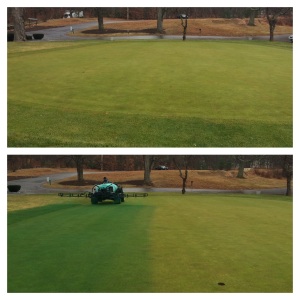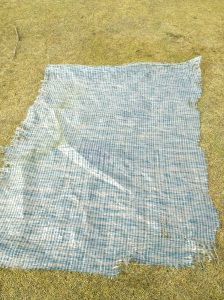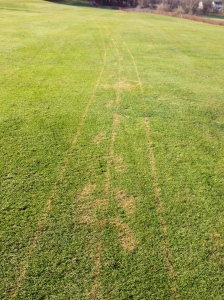Although I posted this last December, it is very applicable to conditions right now. Truthfully, not much changes when winterizing the golf courses. Enjoy.
The winter season is upon us, or is it? We can only hope that the snow falling across the blog screen that you are reading right now would be falling on the actual golf course some time soon. Both courses are fully winterized, well, minus the snow accumulation. The irrigation systems have been blown out, drains have been flushed/open, accessories have been removed for refurbishing, snow mold applications have been applied to greens/tees/fairways, Winter Green has been applied to all 39 greens, and two pin positions have been cut on the front 9 of both courses. Yes, two pin positions. I got this brilliant idea from Russ Heller, a fellow Superintendent here in Massachusetts. Russ also has a great blog seen here: William Devine Golf Course at Franklin Park. Well, the theory behind it is to divert foot traffic on frozen/dormant greens surfaces. Closing the greens or providing temporary greens is not something we do at Stow Acres. This is where snow is helpful in covering the greens, but, in order to preserve playing conditions for the Spring season until snow falls, we cut two pins. We will leave pins in both hole locations allowing the golfer to pick whichever hole location they desire. Once on the green, traffic will be split between both hole locations. We’re doing this primarily because we suffered minor turf damage last season from repetitive foot traffic around one hole location pictured below.
The turf does heal once the weather gets warmer, but as you can imagine, these spots took quite a bit longer to recover. Our assistant superintendent, Kevin Bracken, had a great idea to place modified greens covers over the trampled spots once we could cut the cup in a new position. This certainly accelerated recovery.
Currently, there is no “real” snow in the immediate forecast. However, with the cold temperatures becoming more consistent, we will be covering both practice greens tomorrow to ensure great putting conditions for the Spring. If you plan on playing until it snows, please be mindful of the frozen turf. Greens are most susceptible, so keeping pull carts in the rough and walking on the greens as little as possible will help preserve the surface. I will leave you with a picture of what even foot traffic/pull-cart can do to fairway turf during a frozen morning. Stay warm, play well, and have a great holiday season!
-Jason VanBuskirk, Superintendent




